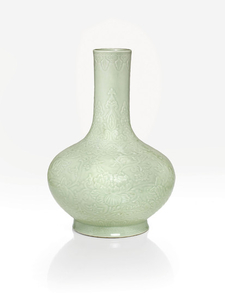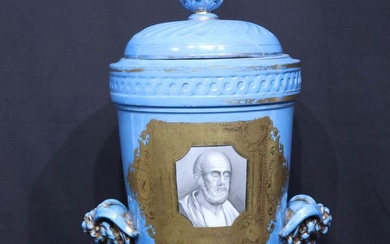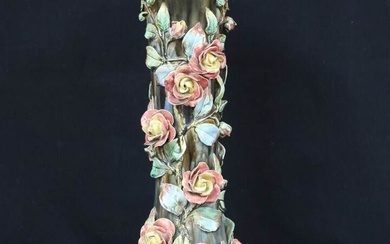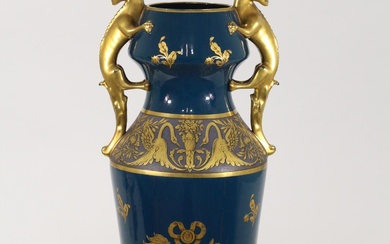RARE ET IMPORTANT VASE EN PORCELAINE EMAILLEE CELADON A DECOR MOULE, CHINE, DYNASTIE QING, MARQUE MOULEE A SIX CARACTERES EN CACHET ET EPOQUE QIANLONG (1736-1795)
RARE ET IMPORTANT VASE EN PORCELAINE EMAILLEE CELADON A DECOR MOULE
CHINE, DYNASTIE QING, MARQUE MOULEE A SIX CARACTERES EN CACHET ET EPOQUE QIANLONG (1736-1795)
Reposant sur un petit pied orné d'une frise de grecques, la panse bombée est délicatement ornée d'un décor moulé de pivoines épanouies parmi des rinceaux feuillagés élégamment disposés. Séparée par une frise de ruyi et une bande de fleurs stylisées, le col tubulaire est agrémenté d'autres pétales et feuillage.
Hauteur: 35 cm. (13 ¾ in.)
Pre-Lot Text
PROPERTY FROM A FRENCH PRIVATE COLLECTION
This current vase belonged to a French gentleman who lived in Hanoi and worked as a clerk since 1927. In 1931, he joined a notary office in Saigon where he worked until the 1950s. Before his final departure to France, his colleagues offered this beautiful vase as a gift to thank him for his honorable contribution. After a long career in Vietnam, his family went back to France and lived in the South-East and then in Paris. In 1982, this vase was mounted as a lamp and offered to their daughter as her 40th birthday gift.
本件乾隆冬青釉刻牡丹紋瓶曾為一位法國紳士的珍藏。他於1927年赴越南生活,1931年至1950年代,他曾就職於西貢一家法國律師事務所。多年後當他決定重返法國時,與他朝夕相處的同事將此瓶做為臨別禮物相送加以答謝。隨後,他協同全家重返故鄉法國生活。1982年,他將這只青釉瓶改裝為檯燈,做為家女四十歲生日禮物贈送於她並收藏至今。
Subtle Extravagance on an Elegant Celadon-glazed Vase
Rosemary Scott, Senior International Academic Consultant, Asian Art
The celadon glaze, which so effectively highlights the shape and decoration of this vase, has its origins in the Song dynasty celadons from the Longquan kilns. Longquan celadon wares continued to be extremely popular during the Yuan dynasty and into the early Ming dynasty. Significantly, it is also clear from archival material that some of the ceramics produced at the Longquan kilns in the early Ming period were being made specifically for the court, under the supervision of government officials sent from the capital. Juan 1094 of the大明會典Da Ming Huidian states that in the 26th year of the Hongwu reign [AD 1393] some imperial wares were fired at the Yao and Chu kilns – i.e. at Jingdezhen in Jiangxi and at the Longquan kilns of Zhejiang.
洪武二十六年定 , 凡燒造供用器皿等物 , 須要定奪樣制 , 計算人工物料 ‘ 如果數多 , 起取人匠赴京置窯興工 , 或數少 , 行移饒 , 處等府燒造.
While in volume one of the明宣宗實錄Ming Xuanzong Shilu it is noted that Emperor Xianzong ascended the throne in the eighth year of the Tianshun reign [AD 1457] and after the Chenghua reign officially began in the following year, an amnesty was declared. It was also noted that the officials sent by the government to supervise ceramic production at the Yaozhou kilns of Jiangxi province and the Chuzhou kilns of Zhejiang province were required to return to the capital as soon as they received the imperial edict. This makes it is clear that there was official production at the Longquan kilns as late as 1457 - the beginning of the Chenghua reign. However, the Longquanxian zhi 龍泉縣志 (Gazetteer of Longquan County) noted that: ‘After the Cheng[hua] and [Hong]zhi reigns [1465-1506], the form [of Longquan wares] became so crude and the colour so unappealing, that they were no longer fit for those of elegant tastes.’
成治以後 , 質粗色惡 , 難充雅玩矣.
Thus, the Ming emperors, and those of the succeeding Qing dynasty, had to look elsewhere for fine celadon-glazed ceramics to replace those formerly manufactured at the Longquan kilns. The Longquan glaze was so admired by the early Ming emperors that the Ming imperial kilns at Jingdezhen were tasked with reproducing a similar celadon glaze on the Jingdezhen white porcelain body. This required the development of a different glaze to the one that had been used on ceramics made with the body material found in the Longquan area, but nevertheless the new glaze was achieved and applied to porcelain vessels in the Xuande reign (1426-35). Extant examples excavated from the Xuande stratum at the imperial kilns include a bowl with flared sides, a flowerpot stand, and a small dish with lobed mouth rim, which are illustrated in Imperial Porcelain of the Yongle and Xuande Periods – Excavated from the Site of the Ming Imperial Factory at Jingdezhen, Hong Kong, 1989, pp. 202-3, no. 60; pp. 214-5, no. 66; and pp. 216-7, no. 67, respectively. However, it fell to the late 17th and 18th century potters at the Qing imperial kilns at Jingdezhen to undertake the research and development which would result in refined, elegant celadon glazes such as that seen on the current vase.
Building on the achievements of the early Ming dynasty imperial kiln, the potters of the Kangxi reign perfected a particularly delicate celadon glaze to be applied over a very white (low iron) porcelain body. This delicate celadon glaze was coloured using only about half the amount of iron found, for instance, in typical Longquan celadon glazes of the Southern Song and Yuan dynasties. The new celadon glaze for porcelain was further modified in the Yongzheng period to produce an even more finely textured and slightly bluer pale celadon glaze, and small adjustments continued to be made in the Qianlong reign – eventually producing a variety of celadon glazes ranging from those which were very pale with bluish tinge, to those which more closely mirrored the colour and texture of early Longquan wares, as is the case with the glaze on the current vase. This range of Qing dynasty celadon glazes has been much admired by Chinese connoisseurs, and individual glazes have been given names such as douqing (豆青 bean green) and dongqing (東青eastern green) in the Kangxi reign, dongqing (冬青winter green) and fenqing (粉青soft green) in the Yongzheng reign. In the Qianlong reign these fine celadon glazes were sometimes used on undecorated pieces - the perfection of the glaze enhancing the elegance of the form. However, celadon glazes were also applied to porcelain vessels with low relief surface decoration, which in the Qianlong reign tended to be quite formal and was often carved to varying levels, allowing a dichromatic effect to develop as the glaze pooled in the deeper recesses and was thinner on the higher elements of the design. The decoration on the current vase lends itself very well to this feature of the glaze, which subtly highlights the elaborate relief design.
Unusually, the six-character impressed seal mark on the base of this vase appears in relief, rather than being incised into the surface of the vessel or being written in underglaze blue. Such relief marks are well-known on Qianlong vessels with brown glazes or those made in imitation of ancient bronze, such as the gu-shaped vase from the Qing Court collection in the Palace Museum, Beijing, illustrated in Porcelains with Cloisonne Enamel Decoration and Famille Rose Decoration, The Complete Collection of Treasures of the Palace Museum, vol. 39, Hong Kong, 1999, p. 169, no. 150. Such relief marks are also found with relative frequency on turquoise-glazed porcelains, such as the crisply-moulded brush washer in the collection of the National Palace Museum, Taipei, illustrated in Catalogue of the Special Exhibition of Ch’ing Dynasty Monochrome Porcelains in the National Palace Museum, Taipei, 1981, pp. 103 and 160, no. 49; the elaborately moulded and pierced hat-stand from the Qing Court collection in the Palace Museum, Beijing, illustrated in Monochrome Porcelains, The Complete Collection of Treasures of the Palace Museum, vol. 37, Hong Kong, 1999, p. 176, no. 159; and the finely-moulded brush washer in the Zhuyuetang Collection, illustrated in Shimmering Colours – Monochromes of the Yuan to Qing Periods – The Zhuyuetang Collection, Hong Kong, 2005, pp. 180-1, no. 107. However, these Qianlong six-character relief seal marks also appear on a small group of celadon wares, which tend to have elaborate formal relief decoration under the glaze, and also tend to have celadon glazes which are closer in colour and texture to those from the Longquan kilns of the Song and Yuan dynasties. A Qianlong lidded jar of this type, with relief mark, from the Qing Court collection is in the Palace Museum, Beijing, and is illustrated in Monochrome Porcelains, op. cit., p. 156, no. 141; while a large twin-handled vase with elaborate decoration and similar distinctive glaze is in the Baur Collection, Geneva (illustrated by John Ayers in Chinese Ceramics in the Baur Collection, vol. 2, Geneva, 1999, pp. 194-5, no. 295) also bears this relief mark.
These two Qianlong celadon-glazed porcelains and the turquoise-glazed porcelains, mentioned above, share with the current vase a very elaborate, but formal, style of decoration, which covers most of the surface of the vessels. Also, similarities can be seen in respect of certain decorative elements. For example, the ruyi heads which alternate with formal leaf motifs around the mouth of the current vase are of the same form as those which encircle the shoulder of the Baur celadon vase, while the well-outlined squared spiral band around the foot of the current vase is reminiscent of the similar bands around the neck torque and lower body of the Baur Collection vase. In addition, comparisons can be made between the very elaborate floral and leaf scrolls on the current vase, those on the turquoise brush washer in the Zhuyuetang Collection, and, even more interestingly, between those on these two monochrome porcelains and the floral and leaf scrolls on elaborately decorated Qianlong enamelled wares, such as the yellow-ground vase from the Qing Court collection in the Palace Museum, Beijing (illustrated in Porcelains with Cloisonne Enamel Decoration and Famille Rose Decoration, op. cit., p. 128, no. 111). However, while the details of the elaborate, well-defined, decoration around the body of the current vase are highlighted by the translucent glaze pooling in the deeper recesses of the design to provide a contrast of colour tones, this is a very understated effect, in contrast to the more immediately apparent decoration on the Beijing enamelled vase. Thus, while the current celadon vase and the enamelled vase share similarly...
View it on
Sale price
Estimate
Time, Location
Auction House
RARE ET IMPORTANT VASE EN PORCELAINE EMAILLEE CELADON A DECOR MOULE
CHINE, DYNASTIE QING, MARQUE MOULEE A SIX CARACTERES EN CACHET ET EPOQUE QIANLONG (1736-1795)
Reposant sur un petit pied orné d'une frise de grecques, la panse bombée est délicatement ornée d'un décor moulé de pivoines épanouies parmi des rinceaux feuillagés élégamment disposés. Séparée par une frise de ruyi et une bande de fleurs stylisées, le col tubulaire est agrémenté d'autres pétales et feuillage.
Hauteur: 35 cm. (13 ¾ in.)
Pre-Lot Text
PROPERTY FROM A FRENCH PRIVATE COLLECTION
This current vase belonged to a French gentleman who lived in Hanoi and worked as a clerk since 1927. In 1931, he joined a notary office in Saigon where he worked until the 1950s. Before his final departure to France, his colleagues offered this beautiful vase as a gift to thank him for his honorable contribution. After a long career in Vietnam, his family went back to France and lived in the South-East and then in Paris. In 1982, this vase was mounted as a lamp and offered to their daughter as her 40th birthday gift.
本件乾隆冬青釉刻牡丹紋瓶曾為一位法國紳士的珍藏。他於1927年赴越南生活,1931年至1950年代,他曾就職於西貢一家法國律師事務所。多年後當他決定重返法國時,與他朝夕相處的同事將此瓶做為臨別禮物相送加以答謝。隨後,他協同全家重返故鄉法國生活。1982年,他將這只青釉瓶改裝為檯燈,做為家女四十歲生日禮物贈送於她並收藏至今。
Subtle Extravagance on an Elegant Celadon-glazed Vase
Rosemary Scott, Senior International Academic Consultant, Asian Art
The celadon glaze, which so effectively highlights the shape and decoration of this vase, has its origins in the Song dynasty celadons from the Longquan kilns. Longquan celadon wares continued to be extremely popular during the Yuan dynasty and into the early Ming dynasty. Significantly, it is also clear from archival material that some of the ceramics produced at the Longquan kilns in the early Ming period were being made specifically for the court, under the supervision of government officials sent from the capital. Juan 1094 of the大明會典Da Ming Huidian states that in the 26th year of the Hongwu reign [AD 1393] some imperial wares were fired at the Yao and Chu kilns – i.e. at Jingdezhen in Jiangxi and at the Longquan kilns of Zhejiang.
洪武二十六年定 , 凡燒造供用器皿等物 , 須要定奪樣制 , 計算人工物料 ‘ 如果數多 , 起取人匠赴京置窯興工 , 或數少 , 行移饒 , 處等府燒造.
While in volume one of the明宣宗實錄Ming Xuanzong Shilu it is noted that Emperor Xianzong ascended the throne in the eighth year of the Tianshun reign [AD 1457] and after the Chenghua reign officially began in the following year, an amnesty was declared. It was also noted that the officials sent by the government to supervise ceramic production at the Yaozhou kilns of Jiangxi province and the Chuzhou kilns of Zhejiang province were required to return to the capital as soon as they received the imperial edict. This makes it is clear that there was official production at the Longquan kilns as late as 1457 - the beginning of the Chenghua reign. However, the Longquanxian zhi 龍泉縣志 (Gazetteer of Longquan County) noted that: ‘After the Cheng[hua] and [Hong]zhi reigns [1465-1506], the form [of Longquan wares] became so crude and the colour so unappealing, that they were no longer fit for those of elegant tastes.’
成治以後 , 質粗色惡 , 難充雅玩矣.
Thus, the Ming emperors, and those of the succeeding Qing dynasty, had to look elsewhere for fine celadon-glazed ceramics to replace those formerly manufactured at the Longquan kilns. The Longquan glaze was so admired by the early Ming emperors that the Ming imperial kilns at Jingdezhen were tasked with reproducing a similar celadon glaze on the Jingdezhen white porcelain body. This required the development of a different glaze to the one that had been used on ceramics made with the body material found in the Longquan area, but nevertheless the new glaze was achieved and applied to porcelain vessels in the Xuande reign (1426-35). Extant examples excavated from the Xuande stratum at the imperial kilns include a bowl with flared sides, a flowerpot stand, and a small dish with lobed mouth rim, which are illustrated in Imperial Porcelain of the Yongle and Xuande Periods – Excavated from the Site of the Ming Imperial Factory at Jingdezhen, Hong Kong, 1989, pp. 202-3, no. 60; pp. 214-5, no. 66; and pp. 216-7, no. 67, respectively. However, it fell to the late 17th and 18th century potters at the Qing imperial kilns at Jingdezhen to undertake the research and development which would result in refined, elegant celadon glazes such as that seen on the current vase.
Building on the achievements of the early Ming dynasty imperial kiln, the potters of the Kangxi reign perfected a particularly delicate celadon glaze to be applied over a very white (low iron) porcelain body. This delicate celadon glaze was coloured using only about half the amount of iron found, for instance, in typical Longquan celadon glazes of the Southern Song and Yuan dynasties. The new celadon glaze for porcelain was further modified in the Yongzheng period to produce an even more finely textured and slightly bluer pale celadon glaze, and small adjustments continued to be made in the Qianlong reign – eventually producing a variety of celadon glazes ranging from those which were very pale with bluish tinge, to those which more closely mirrored the colour and texture of early Longquan wares, as is the case with the glaze on the current vase. This range of Qing dynasty celadon glazes has been much admired by Chinese connoisseurs, and individual glazes have been given names such as douqing (豆青 bean green) and dongqing (東青eastern green) in the Kangxi reign, dongqing (冬青winter green) and fenqing (粉青soft green) in the Yongzheng reign. In the Qianlong reign these fine celadon glazes were sometimes used on undecorated pieces - the perfection of the glaze enhancing the elegance of the form. However, celadon glazes were also applied to porcelain vessels with low relief surface decoration, which in the Qianlong reign tended to be quite formal and was often carved to varying levels, allowing a dichromatic effect to develop as the glaze pooled in the deeper recesses and was thinner on the higher elements of the design. The decoration on the current vase lends itself very well to this feature of the glaze, which subtly highlights the elaborate relief design.
Unusually, the six-character impressed seal mark on the base of this vase appears in relief, rather than being incised into the surface of the vessel or being written in underglaze blue. Such relief marks are well-known on Qianlong vessels with brown glazes or those made in imitation of ancient bronze, such as the gu-shaped vase from the Qing Court collection in the Palace Museum, Beijing, illustrated in Porcelains with Cloisonne Enamel Decoration and Famille Rose Decoration, The Complete Collection of Treasures of the Palace Museum, vol. 39, Hong Kong, 1999, p. 169, no. 150. Such relief marks are also found with relative frequency on turquoise-glazed porcelains, such as the crisply-moulded brush washer in the collection of the National Palace Museum, Taipei, illustrated in Catalogue of the Special Exhibition of Ch’ing Dynasty Monochrome Porcelains in the National Palace Museum, Taipei, 1981, pp. 103 and 160, no. 49; the elaborately moulded and pierced hat-stand from the Qing Court collection in the Palace Museum, Beijing, illustrated in Monochrome Porcelains, The Complete Collection of Treasures of the Palace Museum, vol. 37, Hong Kong, 1999, p. 176, no. 159; and the finely-moulded brush washer in the Zhuyuetang Collection, illustrated in Shimmering Colours – Monochromes of the Yuan to Qing Periods – The Zhuyuetang Collection, Hong Kong, 2005, pp. 180-1, no. 107. However, these Qianlong six-character relief seal marks also appear on a small group of celadon wares, which tend to have elaborate formal relief decoration under the glaze, and also tend to have celadon glazes which are closer in colour and texture to those from the Longquan kilns of the Song and Yuan dynasties. A Qianlong lidded jar of this type, with relief mark, from the Qing Court collection is in the Palace Museum, Beijing, and is illustrated in Monochrome Porcelains, op. cit., p. 156, no. 141; while a large twin-handled vase with elaborate decoration and similar distinctive glaze is in the Baur Collection, Geneva (illustrated by John Ayers in Chinese Ceramics in the Baur Collection, vol. 2, Geneva, 1999, pp. 194-5, no. 295) also bears this relief mark.
These two Qianlong celadon-glazed porcelains and the turquoise-glazed porcelains, mentioned above, share with the current vase a very elaborate, but formal, style of decoration, which covers most of the surface of the vessels. Also, similarities can be seen in respect of certain decorative elements. For example, the ruyi heads which alternate with formal leaf motifs around the mouth of the current vase are of the same form as those which encircle the shoulder of the Baur celadon vase, while the well-outlined squared spiral band around the foot of the current vase is reminiscent of the similar bands around the neck torque and lower body of the Baur Collection vase. In addition, comparisons can be made between the very elaborate floral and leaf scrolls on the current vase, those on the turquoise brush washer in the Zhuyuetang Collection, and, even more interestingly, between those on these two monochrome porcelains and the floral and leaf scrolls on elaborately decorated Qianlong enamelled wares, such as the yellow-ground vase from the Qing Court collection in the Palace Museum, Beijing (illustrated in Porcelains with Cloisonne Enamel Decoration and Famille Rose Decoration, op. cit., p. 128, no. 111). However, while the details of the elaborate, well-defined, decoration around the body of the current vase are highlighted by the translucent glaze pooling in the deeper recesses of the design to provide a contrast of colour tones, this is a very understated effect, in contrast to the more immediately apparent decoration on the Beijing enamelled vase. Thus, while the current celadon vase and the enamelled vase share similarly...







